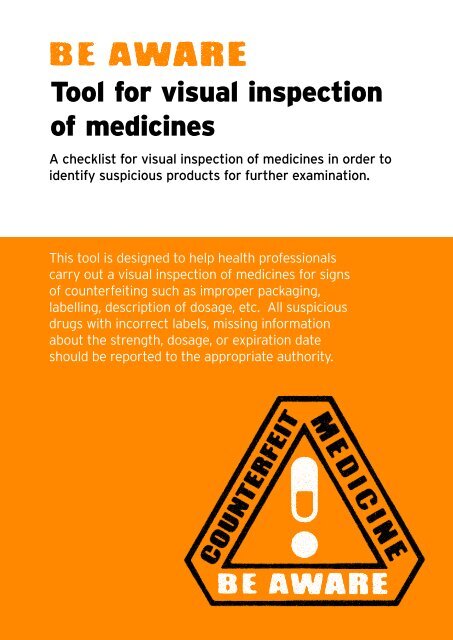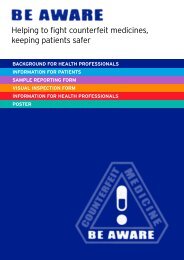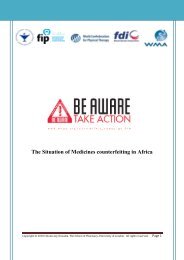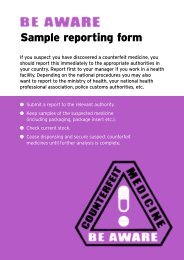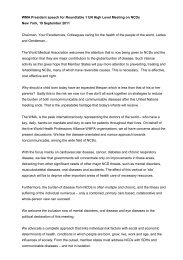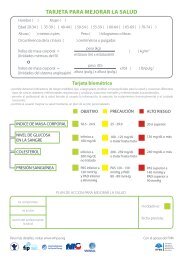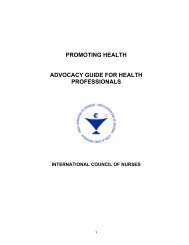visual inspection form
visual inspection form
visual inspection form
You also want an ePaper? Increase the reach of your titles
YUMPU automatically turns print PDFs into web optimized ePapers that Google loves.
Tool for <strong>visual</strong> <strong>inspection</strong><br />
of medicines<br />
A checklist for <strong>visual</strong> <strong>inspection</strong> of medicines in order to<br />
identify suspicious products for further examination.<br />
This tool is designed to help health professionals<br />
carry out a <strong>visual</strong> <strong>inspection</strong> of medicines for signs<br />
of counterfeiting such as improper packaging,<br />
labelling, description of dosage, etc. All suspicious<br />
drugs with incorrect labels, missing in<strong>form</strong>ation<br />
about the strength, dosage, or expiration date<br />
should be reported to the appropriate authority.
1. Packaging<br />
Any drug should be packaged in a container, which can be anything from a glass bottle to a blister pack, to<br />
a tube of glass, plastic or metal. A folding carton bearing the label very often protects the container. Check<br />
the type of packaging and compare it to known containers for the same drug from the same manufacturer.<br />
The packaging and the labelling of pharmaceutical products is a very complex and expensive business.<br />
Thus, the process and the quality of packaging material are very difficult to counterfeit. This is why a<br />
thorough <strong>visual</strong> <strong>inspection</strong> could be an important screening step for drug quality control. However, producers<br />
of counterfeit drugs are quick to copy special labelling and holograms.<br />
1.1 Container and closure<br />
Do the container and closure protect the drug from<br />
the outside environment e.g. properly sealed?<br />
Do they assure that the drug will meet the proper<br />
specifications throughout its shelf life?<br />
Are the container and the closure appropriate for<br />
the drug inside?<br />
Is the container safely sealed?<br />
Yes No Other observations<br />
1.2 Label The in<strong>form</strong>ation written on the label is very important. The in<strong>form</strong>ation can be printed on a<br />
label adhered to the container, or printed directly onto the container itself, but all in<strong>form</strong>ation must be<br />
legible and indelible.<br />
If there is a carton protecting the container, does the<br />
label on the carton match the label on the container?<br />
Is all in<strong>form</strong>ation on the label legible and indelible?<br />
1.2.1 The trade name<br />
Is the trade name spelled correctly?<br />
Is the drug (trade name) registered in the country<br />
by the DRA (drug regulatory authority)?<br />
Is the drug legally sold in the country?<br />
Does the symbol ® follow the trade name?<br />
1.2.2 The active ingredient name (scientific name)<br />
Is the active ingredient name spelled correctly?<br />
Do the trade name and the active ingredient name<br />
correspond to the registered drug?<br />
1.2.3 The manufacturer’s name and logo<br />
Are the manufacturer’s name and logo legible<br />
and correct?<br />
Does the logo or hologram (if applicable)<br />
look authentic?<br />
Does it change colour when viewed from<br />
different angles?
Yes No Other observations<br />
1.2.4 The manufacturer’s full address All manufacturers are required by international law to print<br />
their complete address on the label. Many companies making substandard or counterfeit drugs do not<br />
have a traceable address on the label.<br />
Is the manufacturer’s full address legible and correct?<br />
Has the company or its agent registered the drug in<br />
the country?<br />
1.2.5 The drug strength (mg/unit)<br />
Is the strength - the amount of active ingredient<br />
per unit - clearly stated on the label?<br />
1.2.6 The dosage <strong>form</strong> (e.g., tablet/capsule)<br />
Is the dosage clearly indicated?<br />
Is the indicated drug under this dosage <strong>form</strong> is<br />
registered and authorized for sale in the country?<br />
1.2.7 The number of units per container<br />
Does the number of tablets listed on the label match<br />
the number of tablets stated on the container?<br />
1.2.8 The batch (or lot) number Drugs under the same batch/lot number are expected to be equivalent.<br />
In a continuous process, a batch corresponds to a defined portion of the production, based on time<br />
or quantity. Drugs from the same batch number should have the same history of manufacturing,<br />
processing, packing, and coding. All drug quality control testing should be based on batch/lot numbers.<br />
Does the numbering system on the package<br />
correspond to that of the producing company?<br />
1.2.9 The date of manufacture and the expiry date An expired drug should not be sold under<br />
any circumstances.<br />
Are the manufacture and expiry dates clearly<br />
indicated on the label?<br />
1.3 Leaflet or package insert All drug packages should contain a leaflet explaining dosage, the drug<br />
content, the adverse affects, the drug actions, and how the drug should be taken. The only exceptions<br />
are where the packaging includes all the in<strong>form</strong>ation that would otherwise be in the leaflet.<br />
Is the package insert printed on the same coloured<br />
or same quality paper as the original?<br />
Is the ink on the package insert or packaging<br />
smudge-proof?
2. Physical characteristics of tablets/capsules<br />
All types of medicines can be and have been counterfeited from cough syrups to injections. As mentioned in<br />
Section 1, it is important to check the packaging of these drugs. Additionally, medicines in the <strong>form</strong> of tablets or<br />
capsules can be checked for signs of moisture, dirty marks, abrasion erosion, cracks, or any other adulteration.<br />
2.1 Uni<strong>form</strong>ity of shape<br />
Are the tablets/capsules uni<strong>form</strong> in shape?<br />
Yes No Other observations<br />
2.2 Uni<strong>form</strong>ity of size<br />
Are the tablets/capsules uni<strong>form</strong> in size?<br />
2.3 Uni<strong>form</strong>ity of colour<br />
Are the tablets/capsules uni<strong>form</strong> in colour?<br />
2.4 Uni<strong>form</strong>ity of texture Tablets can be film-coated, sugar-coated or enteric-coated.<br />
Do the tablets have a uni<strong>form</strong> coating?<br />
Is the base of the tablets fully covered?<br />
Are the tablets uni<strong>form</strong>ly polished, free of powder,<br />
and non-sticking?<br />
2.5 Markings (scoring, letters, etc)<br />
Are markings uni<strong>form</strong> and identical?<br />
2.6 Breaks, Cracks and Splits<br />
Are the tablets/capsules free of breaks, cracks, splits<br />
or pinholes?<br />
2.7 Embedded surface spots or contamination<br />
Are the tablets/capsules free of embedded surface<br />
spots and foreign particle contamination?<br />
2.8 Presence of empty capsules in the case of a sample of capsules<br />
Is the sample examined free of empty capsules?<br />
2.9 Smell<br />
Does the medicine smell the same as the original?<br />
Reporting counterfeit medicines<br />
If, after carrying out the above <strong>visual</strong> <strong>inspection</strong>, you suspect you have discovered a counterfeit medicine,<br />
you should report this immediately to your local health authority. Alternatively, you can contact WHO’s<br />
Department of Quality Assurance and Safety of Medicines (QSM):<br />
Quality Assurance and Safety of Medicines (QSM)<br />
Department of Essential Medicines and Policy (EDM)<br />
World Health Organization, CH-1211 Geneva 27, Switzerland<br />
Tel: +41 22 791 37 43 Fax: +41 22 791 47 30<br />
www.who.int/medicines/organization/qsm/activities/qualityassurance/cft/CounterfeitReporting.htm


